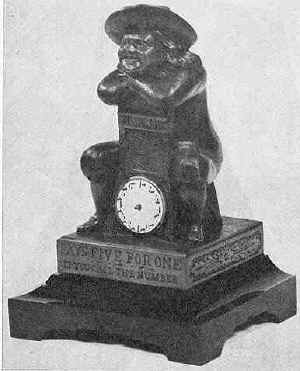Guessing Bank
by F.H. Griffith - HOBBIES Magazine - March, 1962
 A somewhat imposing money box, which verges on being a gambling
device rather than a toy mechanical bank, is our choice as No. 101 in the numerical
classification. The Guessing Bank, as it is appropriately named, is also a complete
departure from the generally accepted idea of a mechanical bank, particularly as to
appearance. It is a rather impressive looking item and, simply expressed, it just
doesn’t look like a child’s toy savings bank or for that matter a toy of any
kind. However, it definitely is a mechanical bank and was patented as such, specifically
as a toy money box.
A somewhat imposing money box, which verges on being a gambling
device rather than a toy mechanical bank, is our choice as No. 101 in the numerical
classification. The Guessing Bank, as it is appropriately named, is also a complete
departure from the generally accepted idea of a mechanical bank, particularly as to
appearance. It is a rather impressive looking item and, simply expressed, it just
doesn’t look like a child’s toy savings bank or for that matter a toy of any
kind. However, it definitely is a mechanical bank and was patented as such, specifically
as a toy money box.
Edward G. McLoughlin of New York City patented the Guessing Bank, May 22, 1877, as an improvement in toy money boxes. The patent papers go on to state that McLoughlin has invented a new and improved toy bank, the object of which is to provide a game of chance in connection with a toy bank. The papers go on from there to explicitly outline the operation and mechanism of the bank. The actual manufacturer of the bank is, to the best of the writer’s knowledge, unknown. However, we are fortunate in having considerable background information due to the man responsible for turning up all known specimens of the bank.
Mr. Mark Haber, the well known collector and dealer in mechanical banks, is the individual who through perserverance found the first example of the Guessing Bank and subsequently the remaining known examples. Mr. Haber has kindly furnished the writer with the information and circumstances surrounding his locating and obtaining the Guessing Banks. Using his own words the story is as follows:
"The discovery of these banks was entirely accidental and unusual, and the lead was furnished by an old picker, who informed me that he thought he noticed something that might be a bank or statuette being used as a door stop at a house in South Windham, Conn. His meager description of the object and the location left me no other alternative but to comb every street in South Windham, until I finally espied the object. It was rusted and weather beaten, but unmistakably the bank patented by E.J. McLoughlin.
"I had little trouble in purchasing the bank from the occupants, Mr. and Mrs. George E. Sherman. Further inquiry revealed that Mr. Sherman’s grandfather had purchased the patent rights and had a number of these banks made up for distribution to jobbers who were to show these to the trade through their salesmen. To the best of his recollection, the orders for these banks were so meager as to make it an unprofitable venture to go into large production. Being possibly a gambling device in the hands of a child it did not seem to have any appeal.
"Further inquiry on subsequent visits revealed that there were a few of the banks left in an old barrel in the original packings in the fine old stable on the estate. Without going into further details, I managed to purchase two or three at each visit for sums of money plus some fine first editions which I always brought with me for Mr. Sherman as gifts. Mr. Sherman collected fine first editions and appreciated my thoughtfulness."
The writer’s example of the bank is pictured. It is in mint condition and was originally obtained from Mr. Haber. The figure of the man sitting astride the chair is a fine detailed casting and is finished in an overall light gold-bronze color. The dial has a white porcelain type finish with black numerals and the base of the bank is a glossy black. Under the name Guessing Bank there appears in raised letters, "Pat. May 22, 1877." This lettering is worked into the design of the chair and is not too obvious.
To operate the bank a coin is dropped into the provided slot in the man’s hat. The weight of the falling coin causes the hair-like pointer on the dial to spin. The pointer, as it revolves, engages the pins placed around the dial and of necessity must stop in one of the numbered areas. If the operator of the bank has guessed the indicated number prior to depositing the coin he is entitled to remove five times the amount deposited. There is a locked removable drawer in the back of the bank for this purpose.
To sum up, the Guessing Bank is a rather large impressive item which does not look like the generally accepted version of a toy mechanical bank. To the best of the writer’s knowledge a limited number of these banks exist, all of which were found by Mr. Haber. It is a very interesting bank and makes an unusual addition to a collection of mechanical banks.
